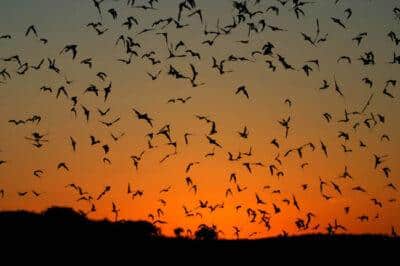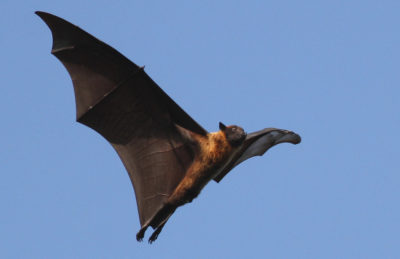|
Listen To The Article
|
Bats are among the most misunderstood creatures on the planet. Many of us fear them and do what we can to keep them away. As a result, we destroy their habitats and kill them by the thousands. While we think this makes us safer from both potential disease and the occasional startle when we see one, bats are in fact more helpful than they are harmful.
Bats help to keep pests that destroy crops and gardens and they help control the spread of disease by insects. In essence, bats are needed in large quantities to keep nature in balance.
Nature’s seeders
Bats are nature’s seeders and as we continue to destroy the earth’s ecological system, they work twice as hard to keep it alive by spreading tree, shrub and plant seeds. They are also pollinators – they pollinate the flowers of the trees that give us cashew nuts and cloves.
Bats that eat fruit can’t digest the seeds so they help to spread new plants such as bananas, avocados, mangoes and figs. Over 95 percent of rain forest regrowth is the result of seeds that bats have spread. In addition, when bats spread seeds and pollen they help other species who depend on the small plants for food, moisture and shelter. In the desert, nectivorous bats pollinate cactus flowers to help keep the ecosystem in check.
Bat droppings are valuable fertilizer
For centuries, farmers have collected bat droppings and used them for fertilizer. In some parts of the world, people still go into caves to collect or “mine” the droppings. They provide excellent nourishment for soil and plants.
Myths about bats
There are many myths surrounding bats. Such as:
Bats are flying mice: Bats are not even remotely related to mice. They are so unique that they actually have their own group called Chiroptera – meaning hand-wing.
The Best Source For Non-GMO Heirloom Seeds Is Right Here! [2]
Bats are actually grouped with other primates and lemurs in the large group called Archonta.
Bats are blind: Bats can actually see as well as humans. Fruit bats not only see in color but have eyesight that is adapted to low light, similar to cats.
Bats are dirty: Bats, like cats, spend a great deal of time grooming. They like to keep their fur clean and soft.
Vampire bats attack humans to suck blood: There are more than 1,100 species of bats and only three are vampire bats. These live mostly in Latin America. Vampire bats are tiny and do not attack humans to suck blood. Instead, they take very small bits of blood from other animals. Most bats are very gentle creatures and quite shy.
Bats carry rabies: Bats can catch rabies just like any other animal but only a few – one-half of one percent – actually contract the disease. This means 99.5 percent do not have the disease.
Bats will chew holes in your attic: The Organization for Bat Conservation tells us that bats will not chew holes in your attic but they will slip into openings so that they can nest.
Attracting bats to your garden
If you desire organic pest control, bats are a definite plus. Research has revealed that bats can devour as many as 600 mosquitoes in one hour. That is a good enough reason for most of us who struggle with these pesky critters to want to attract bats. More bats mean fewer mosquitoes and fewer insects that like to eat our flowering plants and vegetables.
Bats are much like birds in that they prefer a source of shelter and a place to hang out, such as trees or shrubs. You will often find bats resting in abandoned buildings, hollow trees and in loose tree bark. A source of water such as a birdbath or gurgling pond also is a nice addition to a bat-friendly landscape.
Bats are attracted to plants that bloom at night such as yucca, evening primrose, cleome, nicotiana, night-blooming water lily and night-blooming jessamine.
Bat houses
Bat houses are an easy and affordable way to attract more bats to your yard. Make your own bat houses out of rough wood such as cedar or plywood. Bats like a rough texture because it is easier for them to hang on to when they climb in and out of the house. The roughest side of the wood should be on the inside.
To make your bat house appealing, make it two-feet-tall, one-foot-wide and three-inches-deep. Be sure to hang your boxes at least 10 to 15 feet off of the ground on a pole or a tree. The house should be in a sunny spot where it can gather heat during the day. Painting the box black will help attract more bats.
Bats in your home or garage
The only time you should be really concerned about getting rid of a bat is if it is trapped in your home, garage or other structure. The first thing you should do is give the bat a method of escape, such as an open window or door. The more windows you can open, the better. The bat will sense the fresh air and migrate that direction.
Go through your house and shut all doors to try to contain the bat in one location. Be sure not to panic. If you have people in your home that are afraid, it is best to relocate them. If the bat does not fly out, you can try to catch it in a butterfly net once it lands. When you are successful with this, be careful not to crush the bat, they are fragile. Take the trapped bat outside and release it. If you don’t have a net, you can use a plastic container to trap the bat when it lands. It will be excited for a while but when it calms down you can relocate it outside.
You also can toss a light blanket over the bat when it has landed and gently gather the blanket up around it so you can take it outside. Again, be very careful because the bones in bat’s wings are very fragile.
If you are bitten
As was mentioned earlier, bats are not aggressive. However, like all animals, they can bite when scared. If you are bitten and have reason to think that the bat is rabid, seek medical attention and capture the bat so that it can be tested for rabies.
When you have bats living in your home
If you have a colony of bats living somewhere in your home it is best to find a professional who can help you relocate the bats. There are numerous companies that specialize in safe and harmless removal of bats. To prevent bats from entering your home, consider a chimney cap or screen and inspect your home often for cracks leading to the outside, especially in attics.
Bats may be misunderstood, but on the farm or homestead, they can be among your best assets.
How do you attract bats to your land? Why? Share your thoughts in the section below:
Are You Off-Grid? Then Harness The Power Of Nature’s Most Remarkable Healer: Vinegar [4]

